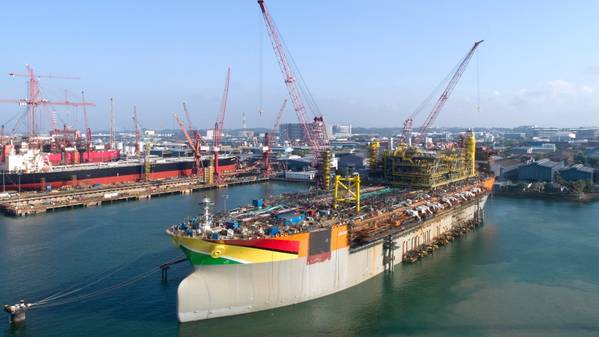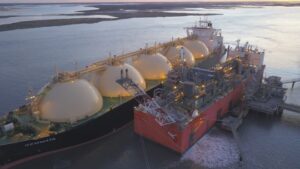
(Petroleum Economist, 31.Jan.2020) — Guyanese offshore success in recent years has become almost synonymous with US giant ExxonMobil—the hot streak of oil discoveries achieved in the country’s waters has added 15 major finds to the firm’s roster and c.6bn bl oe in recoverable reserves. Momentum was further buoyed by the arrival of first oil from the Liza project in December—ahead of schedule and less than five years since the company’s breakthrough find.
But the rapid pace of ExxonMobil’s exploration success in the emerging province is showing little sign of slowing. The firm has now announced a 16th major discovery in the prolific Stabroek block—ownership split between operator ExxonMobil (45pc), US independent Hess (30pc) and China’s Cnooc (25pc)—barely a month after a significant oil-bearing reservoir was struck at the Mako prospect, southeast of Liza.
Drilling at the Uaru prospect, 16km northeast of Liza, encountered 94ft of high-quality petroleum-bearing reservoir. Combined, the discovery increases overall recoverable resources in the Stabroek block to c.8bn bl oe.
“With recent high-quality finds at Tripletail and Mako contributing to our recoverable resources, our investments will continue to provide benefits for the people of Guyana,” said Mike Cousins, senior vice-president of exploration at ExxonMobil. “The Uaru discovery is another positive step as we begin a new decade with the Republic of Guyana and our co-venturers.”
The joint partners will next carry out drill stem testing at the Yellowtail and Longtail discoveries to assess the productive capacity of the fields and next steps for further exploration.
Prime concerns
Ramping up production from Phase 1 of Liza remains the immediate priority for the block partners. Capacity of 120,000bl/d is projected to be achieved over the next few months from the Liza Destiny floating production storage and offloading (FPSO) vessel. A second FPSO will then add an additional 220,000bl/d by mid-2022. ExxonMobil says five drillships will be operating offshore Guyana before year-end.
Guyana’s industry-leading breakeven and development costs are a welcome boon to ExxonMobil’s portfolio. An independent assessment of hydrocarbon projects by research firm RS Energy ranks Liza as the lowest breakeven project globally, below Jubilee in Ghana and Buzzard in the North Sea. According to its modelling, today the breakeven for Liza Phase 1 stands at $35/bl but will be lowered to $25/bl during Phase 2. Development costs will increase slightly from $6/bl oe to $7/bl oe between the development stages.
“Guyana is a key priority in ExxonMobil’s portfolio and a key growth driver,” says Jennifer Rowland, senior energy analyst at US financial firm Edward Jones. “Given the size of the estimated recoverable resource base, there is potential for multiple phases of development in the years ahead.”
The next production target for the block partners will be the Payara field—the second major crude discovery in the Stabroek block. If the joint partners gain approval from the Guyana government, first production could potentially be achieved by 2023 and add an additional 220,000bl/d to output.
The progress of further oil negotiations in Guyana has been muddied since the David Granger administration lost a vote of no-confidence in December 2018. Although the constitution demanded national elections within three months, the motion went to arbitration and has continued to suffer delays, leaving Granger head of an interim government.
But elections have now finally been scheduled for March, pitting the previous incumbent against opposition candidate Irfaan Ali. The opposition had previously complained about the charitable terms of the ExxonMobil contract and pledged to improve royalties in future licensing rounds. But Ali has now promised to uphold existing contracts if his PPP coalition are victorious. Both flanks of the political spectrum are aware of the enormous earnings potential of its offshore reserves—leaving a victory from either side unlikely to disturb the status quo.
Paying premium
Hess, ExxonMobil’s joint partner in two Guyana blocks, has also strengthened its commitments in the nascent province. The company’s capex budget for 2020 strongly prioritises acreage in Guyana, alongside the US Bakken shale play. From a total $3bn budget, $860mn will be allocated to offshore developments in Guyana—split $100mn for Liza Phase 1, $400mn for Liza Phase 2 and $360mn for Payara. An additional $450mn will be assigned to exploration and appraisal of wells in its two blocks—as well as Stabroek, Hess holds a 15pc stake in Kaieteur, together with ExxonMobil (35pc), Israel’s Ratio Energy (25pc) and Canadian Cateleya Energy (25pc).
“Offshore Guyana, with the Liza Phase 1 development now on production, our focus in 2020 will be on the Liza Phase 2 development and on front end engineering design work to develop the Payara Field,” says Greg Hill, Hess’ COO. “We also will continue to invest in an active exploration and appraisal program in Guyana, on both the Stabroek and Kaieteur blocks, and in the deepwater Gulf of Mexico.”
***

